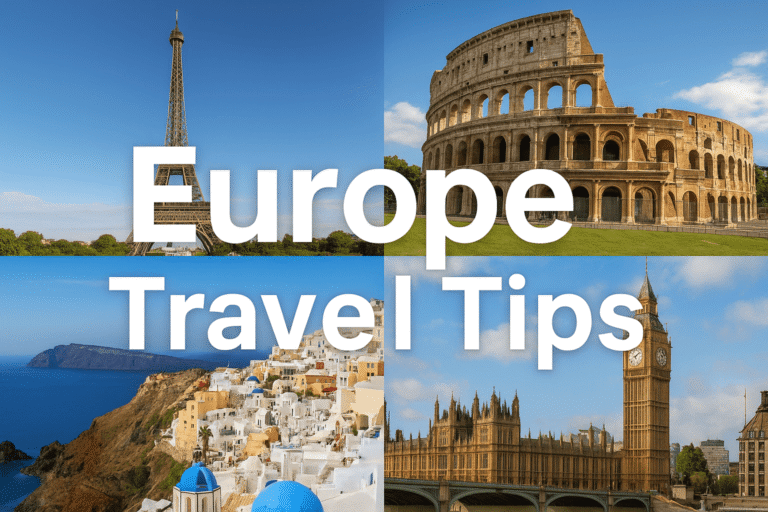
Traveling through Europe is one of the most rewarding experiences for any traveler. With its mix of cultures, languages, history, and modern attractions, Europe is full of surprises at every corner. However, planning a European trip requires smart strategies to save time, money, and avoid common mistakes. In this Europe Travel Tips guide, you’ll find practical advice to make your journey smoother, more affordable, and unforgettable.
1. Plan Your Itinerary Wisely
Europe offers dozens of countries within short distances, but trying to see everything in one trip can be overwhelming. Instead of rushing, choose a few countries or cities to focus on. For example, combining Paris, Amsterdam, and Brussels works well for a 7–10 day trip.
Tip: Group nearby destinations together to save on travel time and costs.
Example: France, Belgium, and the Netherlands are ideal for a Northern Europe itinerary.
2. Choose the Best Time to Visit
Seasonal differences in Europe can drastically affect your trip.
Summer (June–August): Popular but crowded, with higher prices.
Spring (April–June) & Fall (September–October): Great weather, fewer tourists, and more affordable.
Winter (November–February): Perfect for Christmas markets, skiing in the Alps, and budget city trips.
Tip: If you want to avoid large crowds and enjoy better deals, traveling off-season is highly recommended.
3. Budget for Different Costs
Europe can be both budget-friendly and expensive depending on where you go.
Western Europe (France, Germany, UK): Generally more expensive.
Eastern Europe (Poland, Hungary, Romania): More affordable for hotels, food, and attractions.
Tip: Mix expensive destinations with budget-friendly ones to balance your trip.
👉 For inspiration on affordable stays, check out our Top Budget Hotel Deals for Smart Travelers.
4. Save Money on Transportation
Europe is well connected by trains, buses, and budget airlines.
Trains: The Eurail Pass or Interrail Pass (for EU citizens) is a great option if you plan to visit multiple countries.
Flights: Budget airlines like Ryanair, EasyJet, and Wizz Air offer cheap tickets across Europe.
Buses: FlixBus is an affordable option for longer routes.
Local Transport: Most European cities have excellent metro, tram, and bus systems. Buy day passes to save money.
5. Book Accommodation Early
Europe offers a wide range of places to stay—from luxury hotels to affordable hostels and budget hotels.
Tip: Booking in advance gives you better rates and availability.
Budget Travelers: Consider staying in smaller guesthouses, Airbnbs, or budget hotels near public transport hubs.
👉 You can also explore our series on Budget Hotels in U.S. Cities for comparison before booking abroad.
6. Learn Basic Local Phrases
English is widely spoken across Europe, but learning a few basic words in local languages can make your trip smoother and friendlier.
Hello / Thank You / Please in French, Italian, Spanish, or German goes a long way.
Locals appreciate when visitors make the effort.
7. Stay Safe While Traveling
Europe is generally safe, but like any tourist destination, pickpocketing can be an issue in busy areas.
Tip: Use a money belt or crossbody bag to keep valuables secure.
Be aware in crowded places like train stations, markets, and tourist attractions.
Always keep digital copies of your passport and travel insurance documents.
8. Use Technology to Your Advantage
Smartphone apps can make your European adventure stress-free:
Google Maps – For navigation and public transport routes.
Omio – To compare train, bus, and flight tickets.
Booking.com or Trip.com – For hotels and accommodations.
Google Translate – Helpful when traveling in non-English-speaking regions.
9. Try Local Food Experiences
One of the best parts of traveling in Europe is the food. From Italian pizza and pasta to Spanish tapas and German pretzels, every country has unique flavors.
Tip: Avoid eating at touristy restaurants near major attractions. Explore side streets and local markets for authentic meals at better prices.
10. Pack Smart and Light
European travel often involves moving between cities, so packing light will make your trip easier.
Use a carry-on suitcase or backpack.
Pack comfortable walking shoes.
Include layers for changing weather.
Carry a reusable water bottle to save money and reduce plastic waste.
11. Explore Beyond Famous Cities
While Paris, Rome, and London are must-visits, Europe has countless hidden gems.
Portugal: Porto and Lisbon for culture and coastal charm.
Hungary: Budapest for thermal baths and vibrant nightlife.
Slovenia: Lake Bled for stunning scenery.
Exploring smaller towns often provides a more authentic and budget-friendly experience.
12. Take Advantage of Free Attractions
Many European cities offer free or discounted entry to attractions on certain days.
Museums in Paris: Free on the first Sunday of each month.
London Museums: Many are free all year round.
Walking Tours: Free walking tours are available in most major cities.
Related Guides for Smart Travelers
Planning a trip beyond Europe? Read our USA Travel Tips for insights on American travel.
Discover budget stays across Asia to compare global options.
Learn more about our Affiliate Disclosure and Privacy Policy for transparency.
Conclusion: Travel Smarter in Europe
Europe offers something for everyone—whether it’s history, culture, food, or adventure. By following these Europe travel tips, you’ll be able to save money, stay safe, and experience the continent like a pro. From choosing the right time to visit to exploring beyond the big cities, smart planning ensures your European journey will be both memorable and stress-free